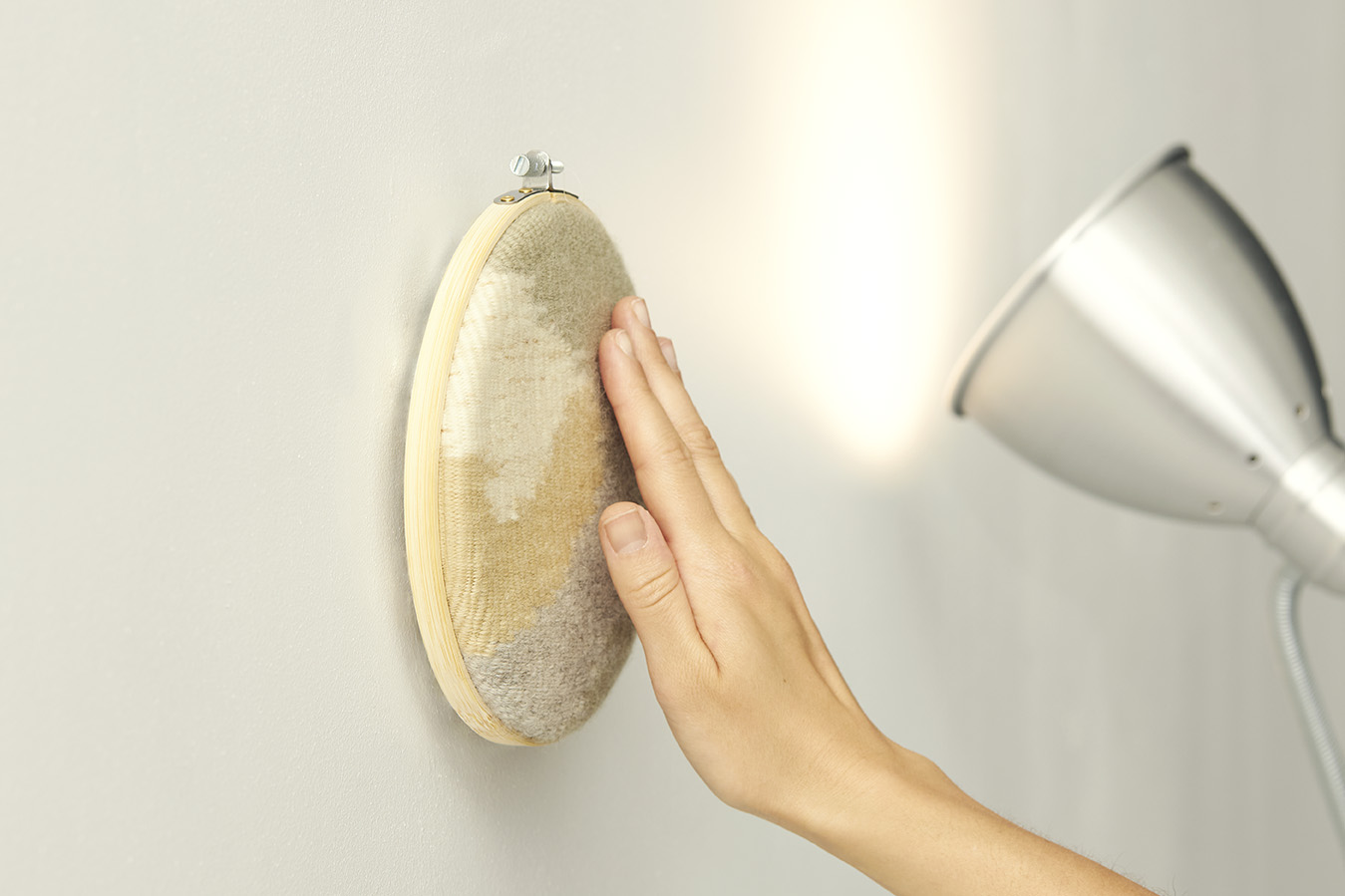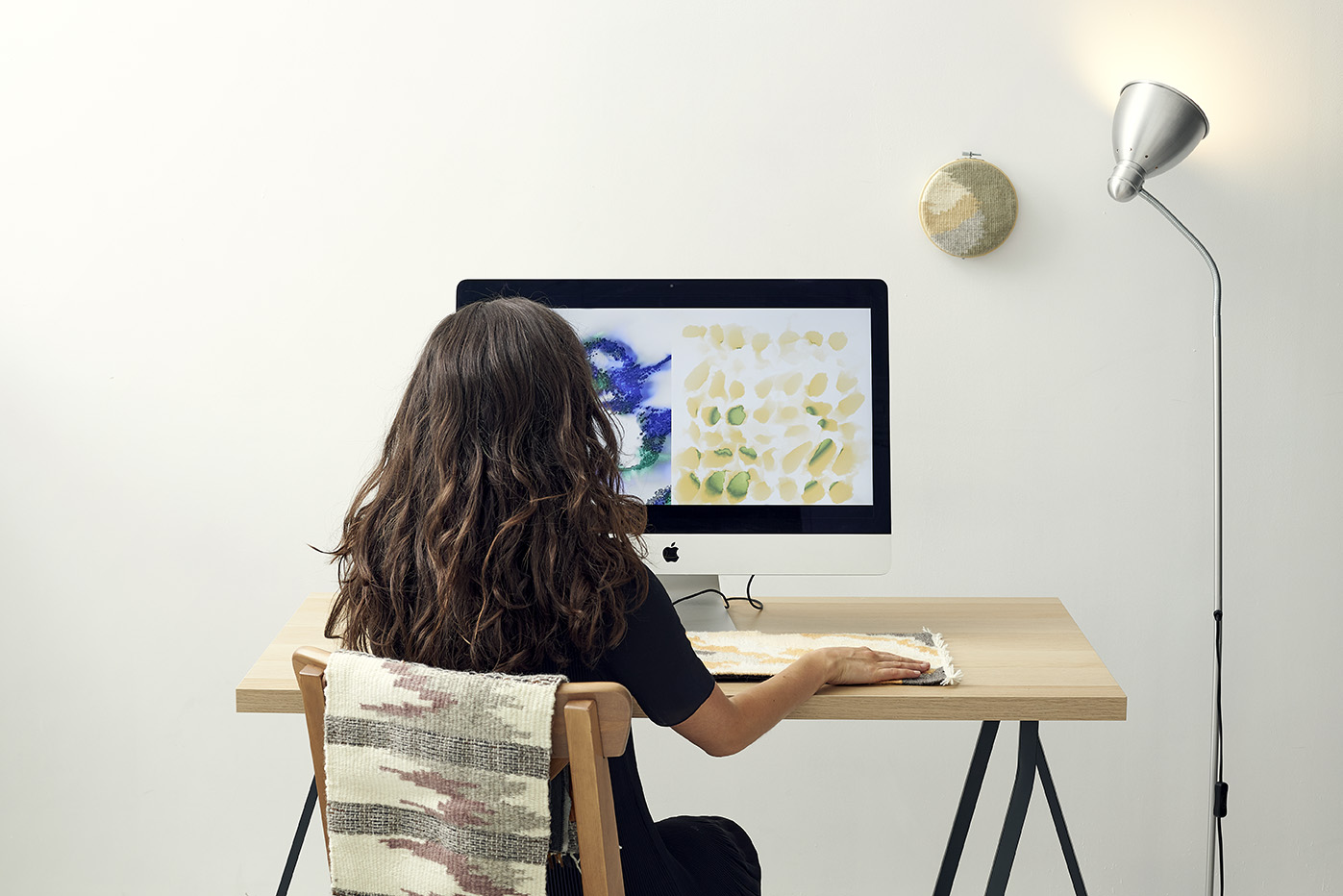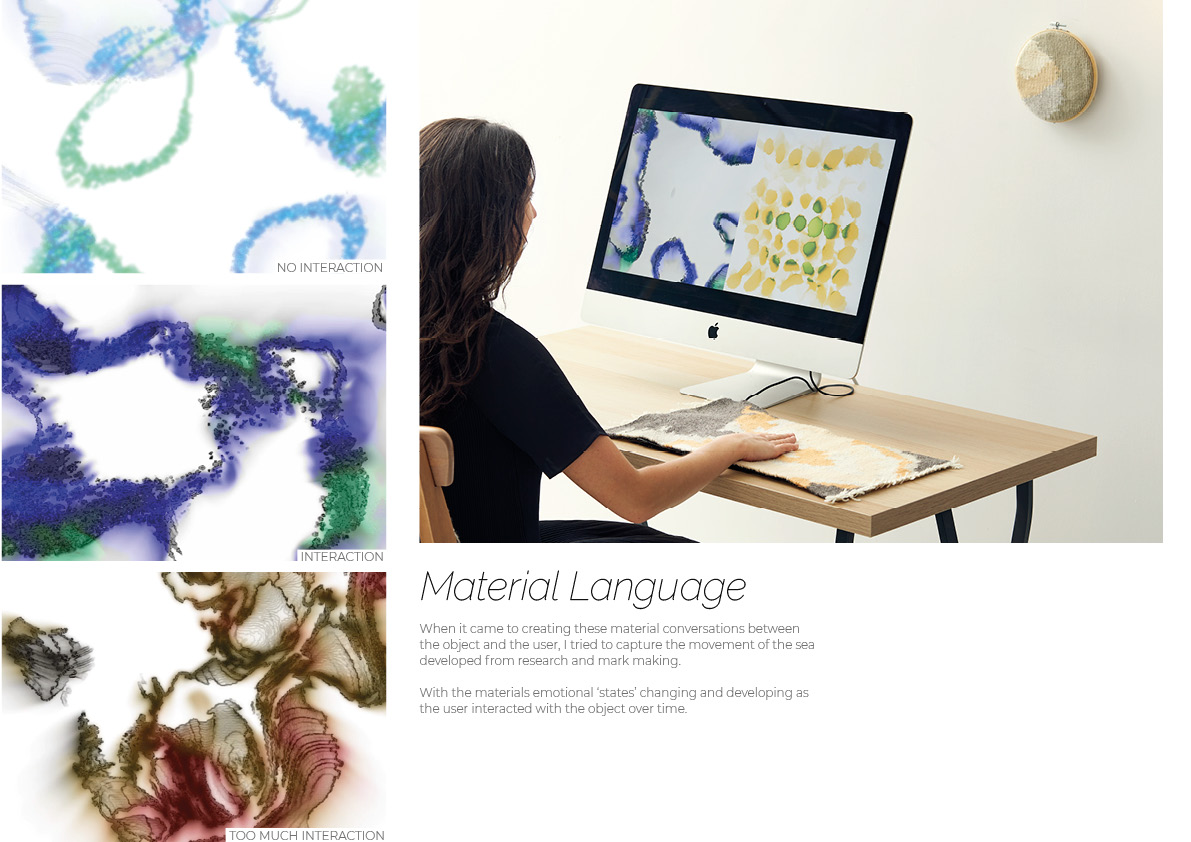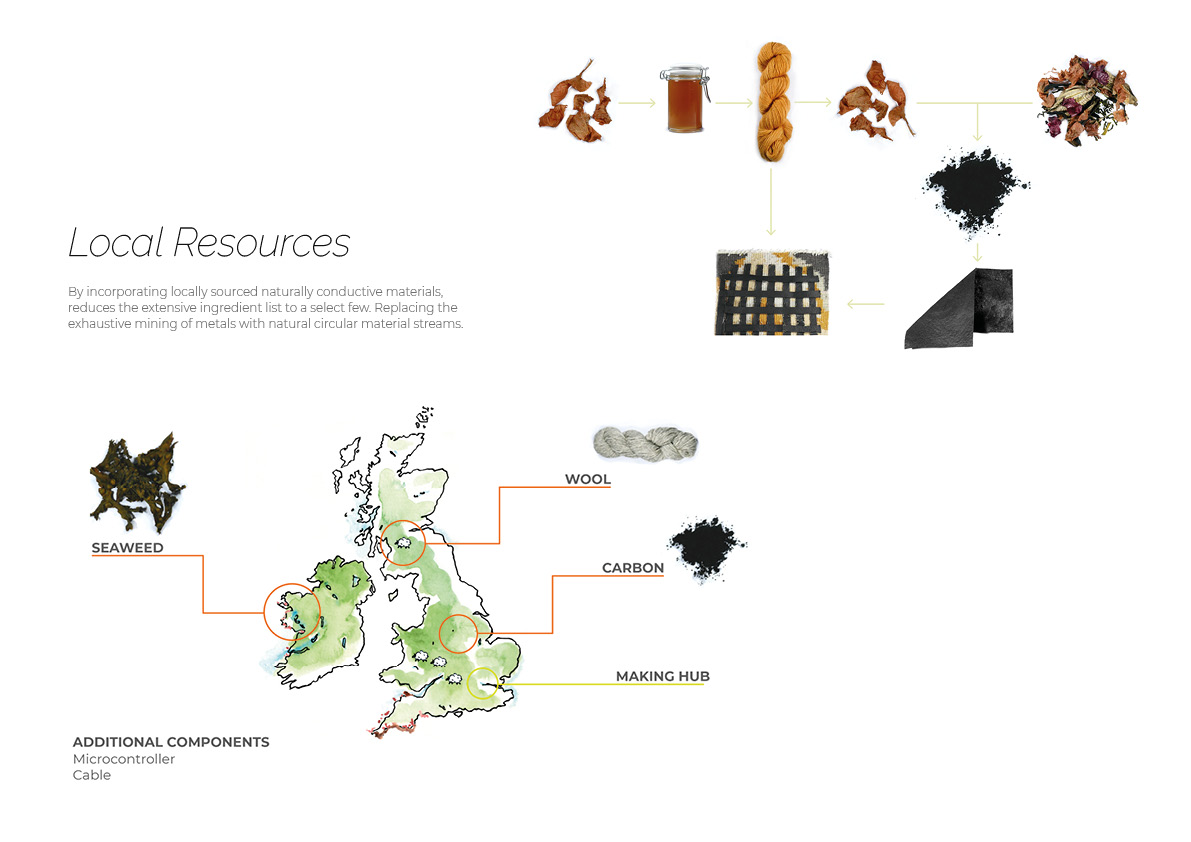Home Grown is a bio-based collection of e-products, offering a sustainable alternative to the consumer electronics we use today. Inspired by the lack of mindfulness regarding the sourcing and recycling of materials for technology, Home Grown has been sourced from local materials from the UK & Ireland and created using traditional craft techniques. It uses ambient technology as a visual language to uncover the relationship between these objects and the user, exploring how levels of care towards these within our daily interactions, can create a deeper understanding and longevity within the everyday object.
In 2019 the world generated a striking 53.6Mt of e-waste. This figure, from the UN, was my initial motivation by the lack of mindfulness for the afterlife of e-products. Inspiring me to explore materials and ideas that could produce alternative solutions to the way we source and create materials for technology. Exploring local conductive and bio-based materials that could create speculative alternatives for the current multi-national ingredient list within technologies today. Replacing the metal components and interfaces whilst reducing the material, and the making process to a localised area, using traditional techniques such as tapestry.
Home Grown is an ambitious project reimagining the future of technology as soft and sustainable, through the creation of a collection of bio-based electronics that asks consumers to imagine a world where technology is created in local areas from local craftspeople. It uses ambient technology as a visual language to reveal the relationship between these objects and the user, exploring how levels of care within our daily interactions, can create a deeper understanding and longevity for the everyday object.
Home Grown is a creation of three bio-based e-products as a healthier alternative to the current plastic and metal interfaces – by sourcing bio-based materials within the UK and Ireland, compared to the multinational ingredient list in many of today’s e-products. Reducing the carbon footprint and the exhaustive use of metals and petroleum. Moving away from universal design practices by using craft techniques to create products that are unique to areas they’re manufactured within. For instance, in Europe wool is used for the exterior shell, but in regions of India, Jute may be used instead. Generating concepts around pluri-verse designs, to create e-products that are bespoke to an area regarding local sustainably harvested materials, and supporting community-based manufacturing, with the aim to create a stronger emotional connection with our products if we can relate and respect the area it was created within.
The conductive biomaterials are key within all the products to replace the wires and sensors with the conductive and piezo resistive properties of the carbon within my biomaterial, while the exterior replaces the traditional hard casing of an e-product with a soft, tactile alternative using various weaving techniques.
Hand weaving became key as I was able to hack hand looms to manipulate my biomaterial within the weaving process. The technique Tacqueté allowed the biomaterial to be completely hidden in certain sections, and not in others, allowing me to easily apply a resistor matrix to map the movement and quality of touch by the user.
Home Grown is essentially three stories about three objects; one is an alternative tactile tool to work with. Two, is a speculative version of the light switch and the third, is a tool/monitor to aid us throughout our daily lives. These stories aren’t necessarily archetypal hero stories to save the planet, but more mindful approaches about the everyday interactions and rituals that go unnoticed, actions that when realised, could have a larger positive impact towards the planet.
The first is a Touchpad; This piece has been created to develop a more tactile relationship between ourselves and our computers. This Touchpad enjoys resting but also enjoys being interacted with by the user. It can withstand long hours of use, however there is still a limit. If the user has been continuously at work with no breaks, the touchpad becomes unsettled and in need of a break, sending a reminder to the user when its limit has been breached. This in turn, reminds the user to also take a break, with the touch pad not working until a set period of time has passed. This object creates a gentle reminder to be more mindful of the objects and space around you, and how you interact with them, without taking advantage. The care relationship is two way, with the Touchpads need for a break reflecting the needs of the user.
The second is a Light Switch; The Light Switch is a perfect example of an everyday object that goes unnoticed but plays a key role within our homes. This light switch enjoys people’s company and interactions, but if it’s switched on for a period of time without anyone present, it will become upset as it has been forgotten about. The light switch will send a signal to alert the user it has been left unnoticed and wasting energy, creating a reminder that we mustn’t forget about the everyday habits that help us manage our energy consumption.
The third is a Sensory Blanket; Although this object may not be a speculative alternative for a traditional home object, this story, I believe, creates an awareness of how many objects provide selfless acts of care to the end user. This Blanket is mindful of your interaction with it. If you place it on a chair it detects your movement with pressure sensors, sending a gentle reminder if you haven’t moved, or changed position in a while, which is needed within many stationary working positions. Although this Blanket doesn’t require much fuss it does require a medium level of humidity within the room. Sending a reminder when humidity levels are low to give it a gentle spritz when needed, to raise the humidity levels. This Blanket is designed to remind us to respect the objects we use around us by providing a more active form of care for the objects needs, even if this doesn’t directly relate to ours.
The visual interactions have been created using the data detected through the pressure sensors on each of the products through the piezo resistive properties of the conductive biomaterials. This range of data is then fed through Design Touch to create three ‘emotional states’ of interaction. This first state indicates when the object has been interreacted with, the second is when the object notices there’s interaction. And the third is when the user has interacted too much with the object. Each ‘emotional state’ aesthetics has been inspired by my mark making and drawings from the landscapes the materials originated from. In this case, from the sea and coastlines around the UK & Ireland.
Could the future potential of this ambient technology allow the products to communicate with us, and update us when its life cycle is coming to an end? Reaching out across the Internet of Things to reach out to other objects, and materials, that have come from the same Maker.
Understanding a material’s needs through ambient technology has the potential to create a deeper level of care, with the hope of stimulating and evolving future relationships with our materials. Imagine if we saw these items not just as pieces of technology, but as part of the intimate environment of the home, giving them the same level of respect and care as you would a house plant.
How have these objects also addressed the sustainable problems?
– It addresses the key issues of sourcing local materials and reducing the multinational ingredient list within many technological objects. All these materials come from regenerative agriculture, which focuses on developing the biodiversity and fertility of soil and aquatic environments, as the basis of the entire farm ecosystem.
– The carbon has the potential to be completely derived from organic matter, in particular from the plant matter used for the natural dye and waste seaweed from the biomaterials.
– All the materials, aside from the microcontroller, are bio based therefore can be disposed of safely or recycled into new materials streams, reducing material value loss.
I see the future of my objects progressing into growing centres for technology, where performance is measured through materials locality as well as seasonality. For instance, technologies grown in some parts of Asia will have access to different resources, such as cotton, compared to Northern Europe which may have wool has their prominent textile material. These changing materials, potentially, can vary the way technology performs or the function it carries out?
Can these technologies evolve into regenerative systems where the electricity isn’t passed through the material but instead harvested from the living systems within the material, for instance live bacteria colonies?
As we move forward and develop these new empathetic living mediums and materials, new metrics and language will be needed to measure and communicate these in systems and materials. Can data from living systems be translated into a language that reveals how the living system is responding to the environment and interacting with us, with digital platforms becoming the space in which we access and visualise these intimate conversations?
Evolving ideas around sustainability that aren’t about sustaining ourselves on this planet but respecting the environment in which we live in are vital. Not necessarily programming or engineering bio matter but designing around how this living system grows. Co designing with nature.
Next steps would involve developing the visual language between object and user, and how effectively can this be introduced to create stories of care and stronger relationships between our objects and the user. Other developments would include replacing the microcontroller and resistors with bio-based alternatives, would this mean collaborating with other companies’ technologies? The energy consumption of the biomaterials manufacturing and carbonisation process is high. How could I look to reduce this energy consumption within the process as well as use renewable sources and offset the carbon elsewhere?
Ultimately, I’m looking to inspire a way in which we design, interact and consume technology. Creating a new language and system that describes this next evolution, moving away from restrictive design forms, and devising an unbiased methodology towards crafting technology. Essentially Home Grown isn’t about generating a ‘Hero’ solution or idea to save the planet, but stimulating alternative materials, methods and stories of interaction to create more mindful approaches towards the everyday object. Stimulating a positive change for the many and not just for the select few.


Home Grown
London, UK
Emma positions herself as a sustainable communicator and innovator within textiles across product design fields. Developing stories and accessible information for designers to create more insightful and empathetic depictions that co-design with the environment and its season. Communicating these ideas using an amalgamation of hand craft techniques, biobased materials and ambient technology, to create a visual language between us and our surroundings.
Her interests focus on the boundaries between nature and technology. Using textiles as a tool to develop alternative products within technology and speculative thinking in how we interact, and care, with our everyday environments.
Pushing sustainable materials and thinking. Highlighting the importance of knowing were our materials come from, how we use and what happens to them afterwards. Approaching concepts with a multi skilled approach and collaborating across a variety of fields to work towards a meaning greater good.







